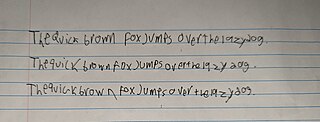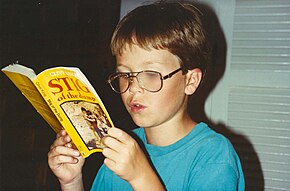
Dyslexia, previously known as word blindness, is a learning disability that affects either reading or writing. Different people are affected to different degrees. Problems may include difficulties in spelling words, reading quickly, writing words, "sounding out" words in the head, pronouncing words when reading aloud and understanding what one reads. Often these difficulties are first noticed at school. The difficulties are involuntary, and people with this disorder have a normal desire to learn. People with dyslexia have higher rates of attention deficit hyperactivity disorder (ADHD), developmental language disorders, and difficulties with numbers.

Phonics is a method for teaching reading and writing to beginners. To use phonics is to teach the relationship between the sounds of the spoken language (phonemes), and the letters (graphemes) or groups of letters or syllables of the written language. Phonics is also known as the alphabetic principle or the alphabetic code. It can be used with any writing system that is alphabetic, such as that of English, Russian, and most other languages. Phonics is also sometimes used as part of the process of teaching Chinese people to read and write Chinese characters, which are not alphabetic, using pinyin, which is.

Dysgraphia is a neurological disorder and learning disability that concerns impairments in written expression, which affects the ability to write, primarily handwriting, but also coherence. It is a specific learning disability (SLD) as well as a transcription disability, meaning that it is a writing disorder associated with impaired handwriting, orthographic coding and finger sequencing. It often overlaps with other learning disabilities and neurodevelopmental disorders such as speech impairment, attention deficit hyperactivity disorder (ADHD) or developmental coordination disorder (DCD).
Reading for special needs has become an area of interest as the understanding of reading has improved. Teaching children with special needs how to read was not historically pursued due to perspectives of a Reading Readiness model. This model assumes that a reader must learn to read in a hierarchical manner such that one skill must be mastered before learning the next skill. This approach often led to teaching sub-skills of reading in a decontextualized manner. This style of teaching made it difficult for children to master these early skills, and as a result, did not advance to more advanced literacy instruction and often continued to receive age-inappropriate instruction.
Phonological awareness is an individual's awareness of the phonological structure, or sound structure, of words. Phonological awareness is an important and reliable predictor of later reading ability and has, therefore, been the focus of much research.

Synthetic phonics, also known as blended phonics or inductive phonics, is a method of teaching English reading which first teaches the letter sounds and then builds up to blending these sounds together to achieve full pronunciation of whole words.
A reading disability is a condition in which a person displays difficulty reading. Examples of reading disabilities include: developmental dyslexia, And alexia,
Inventive spelling is the use of unconventional spellings of words.
The Orton-Gillingham approach is a multisensory phonics technique for remedial reading instruction developed in the early-20th century. It is practiced as a direct, explicit, cognitive, cumulative, and multi-sensory approach. While it is most commonly associated with teaching individuals with dyslexia, it is highly effective for all individuals learning to read, spell, and write. In the US, it is promoted by more than 15 commercial programs as well as several private schools for students with dyslexia and related learning disabilities.
Samuel Torrey Orton was an American physician who pioneered the study of learning disabilities. He examined the causes and treatment of dyslexia.
Grace Maxwell Fernald was an educational psychologist and influential figure in early twentieth century literacy education. Fernald established "the first clinic for remedial instruction in 1921 at the University of California, Los Angeles". Tracing tactile learning tendencies back to Quintilian, Séguin, and Montessori, Fernald's kinesthetic spelling and reading method prompted struggling students to trace words. Years of research culminated in 1943 with her classic work, Remedial Techniques in Basic School Subjects. The popular kinesthetic method anchors modern instruction in the areas of special education and remedial reading. Kinesthetic learning is also included as one of Howard Gardner's multiple intelligences. Fernald's notion of incorporating the physical with the auditory, verbal, and visual elements of reading instruction, now known as "VAKT", multimodal learning, or multisensory imagery, continues to guide educators today.
Anna Gillingham (1878–1963) was an educator and psychologist, known for her contributions to the Orton-Gillingham method for teaching children with dyslexia how to read.

Reading is the process of taking in the sense or meaning of letters, symbols, etc., especially by sight or touch.
Language-based learning disabilities or LBLD are "heterogeneous" neurological differences that can affect skills such as listening, reasoning, speaking, reading, writing, and math calculations. It is also associated with movement, coordination, and direct attention. LBLD is not usually identified until the child reaches school age. Most people with this disability find it hard to communicate, to express ideas efficiently and what they say may be ambiguous and hard to understand It is a neurological difference. It is often hereditary, and is frequently associated to specific language problems.
The history of dyslexia research spans from the late 1800s to the present.
Dyslexia is a reading disorder wherein an individual experiences trouble with reading. Individuals with dyslexia have normal levels of intelligence but can exhibit difficulties with spelling, reading fluency, pronunciation, "sounding out" words, writing out words, and reading comprehension. The neurological nature and underlying causes of dyslexia are an active area of research. However, some experts believe that the distinction of dyslexia as a separate reading disorder and therefore recognized disability is a topic of some controversy.
Dyslexia is a complex, lifelong disorder involving difficulty in learning to read or interpret words, letters and other symbols. Dyslexia does not affect general intelligence, but is often co-diagnosed with ADHD. There are at least three sub-types of dyslexia that have been recognized by researchers: orthographic, or surface dyslexia, phonological dyslexia and mixed dyslexia where individuals exhibit symptoms of both orthographic and phonological dyslexia. Studies have shown that dyslexia is genetic and can be passed down through families, but it is important to note that, although a genetic disorder, there is no specific locus in the brain for reading and writing. The human brain does have language centers, but written language is a cultural artifact, and a very complex one requiring brain regions designed to recognize and interpret written symbols as representations of language in rapid synchronization. The complexity of the system and the lack of genetic predisposition for it is one possible explanation for the difficulty in acquiring and understanding written language.

Dyslexia is a disorder characterized by problems with the visual notation of speech, which in most languages of European origin are problems with alphabet writing systems which have a phonetic construction. Examples of these issues can be problems speaking in full sentences, problems correctly articulating Rs and Ls as well as Ms and Ns, mixing up sounds in multi-syllabic words, problems of immature speech such as "wed and gween" instead of "red and green".
The Kildonan School was a private coeducational boarding and day school in Amenia, New York for students with dyslexia and language-based learning disabilities. It offered daily one-to-one Orton-Gillingham language remediation and a college preparatory curriculum for students in grades 2-12 and PG (post-graduate).
Bessie Whitmore Stillman (1871-1947) was an educator and contributor to the Orton-Gillingham teaching method for students with disabilities in reading.






